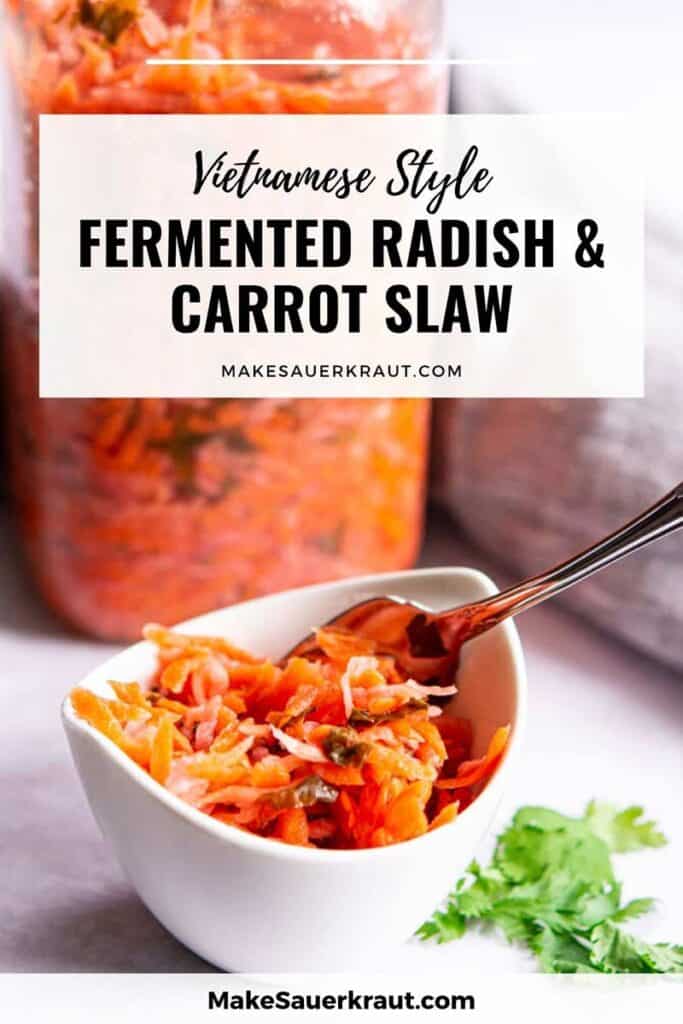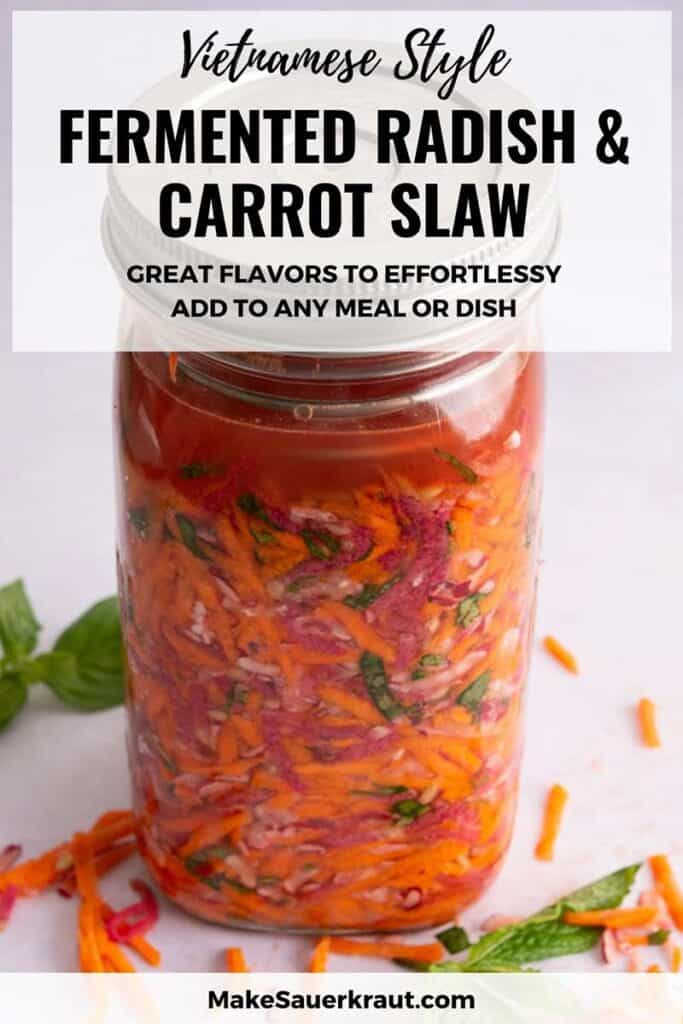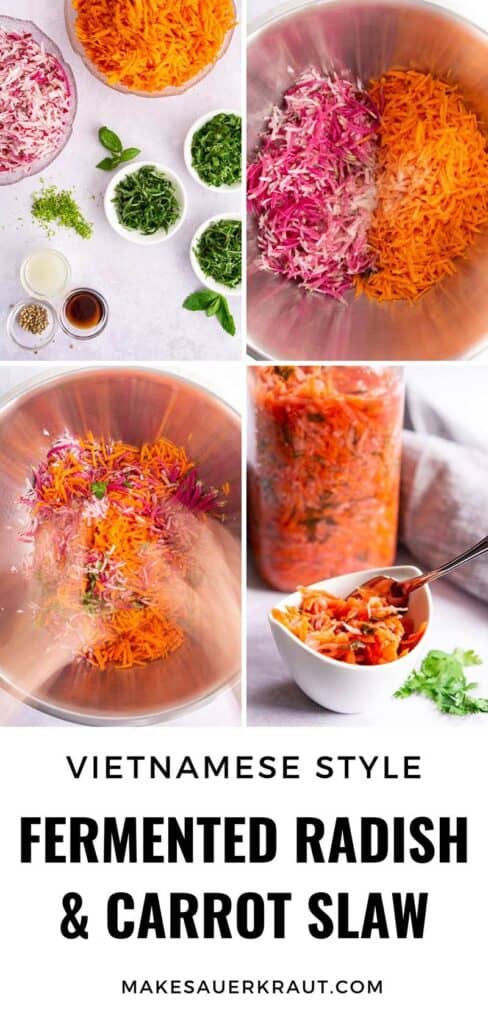I’m here to let you in on a little secret of mine that will simplify your life, help you eat more vegetables, and improve your gut health. Prep, flavor, and preserve—through fermentation—this recipe for Vietnamese-Style Fermented Radish and Carrots Slaw and store it in your fridge. Then, when you go to make a salad, put together a sandwich, build a Buddha bowl, or whatever else you’re getting ready to eat, grab that beautiful jar that is teeming with beneficial bacteria and slop some on. Happy Belly. Happy You.
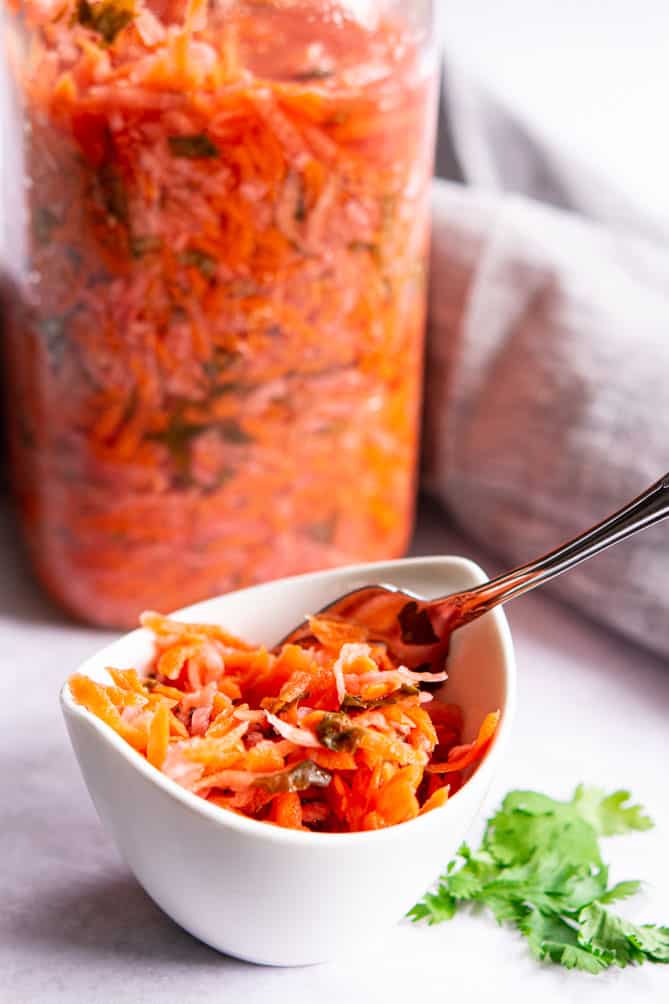
Just like with my set of mouthwatering sauerkraut recipes, in this recipe for Vietnamese-Style Fermented Radish and Carrots Slaw, I created an amazing set of flavors that will shine with any dish. The classic combination of basil, mint, cilantro, and lime is added to shredded carrots and radishes and fermented for 5-7 days.
You will see many recipes for pickled radishes and carrots with similar ingredients, but the pickling process, as further explained below, kills off the digestion-boosting bacteria while the fermentation process retains them.
Fifteen to twenty minutes of slicing—and a week of work by our mighty, microbial friends—will save you oodles of time down the road and bite-by-bite improve your digestion and overall health.
Once you have a jar of Vietnamese-Style Fermented Radish and Carrot Slaw at the ready in your fridge, throwing together a flavorful, healthy meal is so easy. Below, I give directions for a grilled chicken sandwich, a burger with Sriracha Mayo, tacos, a Buddha bowl, or Vietnamese slaw.
- The Power of Fermented Vegetables for Optimal Gut Diversity?
- FAQs: Fermented Radish and Carrots Slaw
- How to Make Fermented Radish and Carrots Slaw
- Ninja Tips for Fermentation Success: Stack the Deck in Your Favor
- Gourmet Pairing Tips: 5 Ways to Use that Jar of Fermented Radish and Carrots Slaw Sitting in your Fridge
- Recipe for Vietnamese-Style Fermented Radish and Carrots Slaw
- Other Flavorful Ways to Make Meals Easy
The Power of Fermented Vegetables for Optimal Gut Diversity?
One of the biggest takeaways from the world’s largest microbiome study is that eating more than 30 different plants per week yields optimal gut diversity for better health.
The trillions of bacteria living in our guts like diversity. Why not make it easy to feed them a variety of foods?
One serving of Vietnamese-Style Fermented Radish and Carrot Slaw effortlessly—and flavorfully—adds seven vegetables to your meal. How easy is that?
And, since these vegetables are fermented, they are easier for your body to digest, the nutrients in them are absorbed at higher levels, and they are loaded with probiotics.
FAQs: Fermented Radish and Carrots Slaw
What’s the difference between pickled carrots and radishes and fermented carrots and radishes?
Pickled is a general term and refers to the process of preserving foods in an acidic liquid—vinegar, lemon juice, or a naturally created one.
When we hear the term pickle, most think of that dill pickle spear commonly served alongside a sandwich. Usually, these and other modern-day pickles have been preserved with vinegar, which has been heated to sterilize the vegetables and destroy all bacteria—both the beneficial and the pathogenic bacteria.
When we naturally ferment fruits or vegetables, instead of adding an acid, like vinegar, to the vegetables, we mix in salt to create a brine in which the vegetables are fermented.
Bacteria naturally present on the vegetables eat the sugars in the vegetables and produce lactic acid, a natural preservative with a tangy taste similar to vinegar. Beneficial bacteria are preserved. Pathogenic bacteria cannot survive in the salty, acidic brine and die off.
Our great ancestors knew what they were doing. Preserving the harvest and preserving the gut-healthy bacteria.
How spicy are fermented radishes?
During fermentation, radishes lose their tangy bite which allows the flavors of the fresh herbs in this recipe to shine.
How long will my ferment last?
Typically, you can expect your jar of fermented radishes and carrots to last a year, but if you’re like most, they will be gone long before then.
What type of radishes can I ferment?
Radishes come in all shapes, sizes, and colors leaving creative room for not only what you use but how you prepare them. Whole? Sliced? Diced? Grated? Julienned?
For fermentation success, ideally use vegetables that are fresh, in season, and locally available. The smaller radishes appear in spring with the larger varieties appearing later in the season.
When selecting radishes, look for ones that are bright and firm, ideally with their greens still attached, a clear sign of freshness. However, when storing fresh radishes, remove their greens. They will last longer.
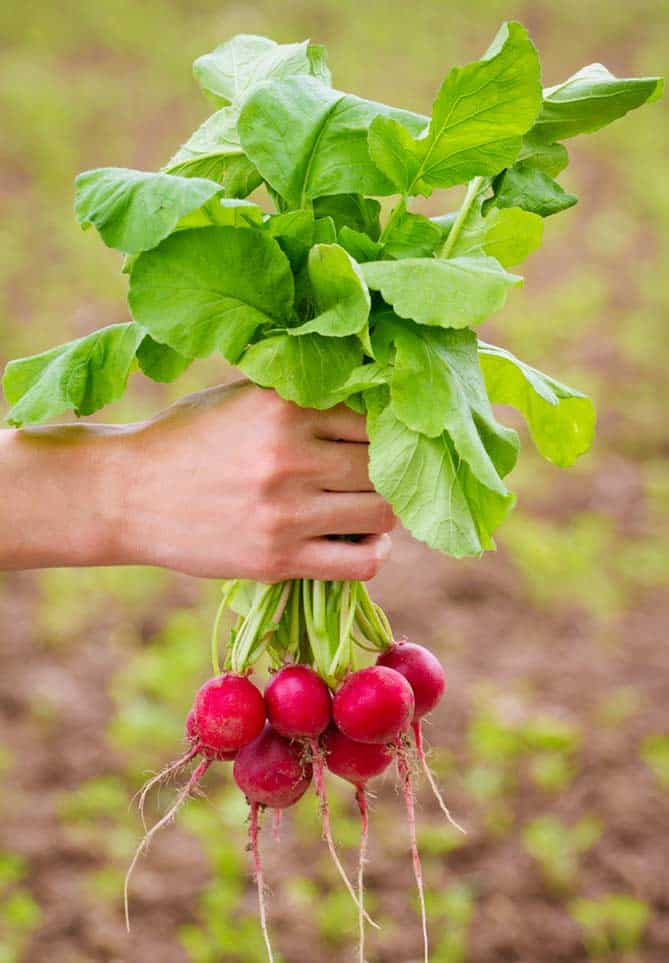
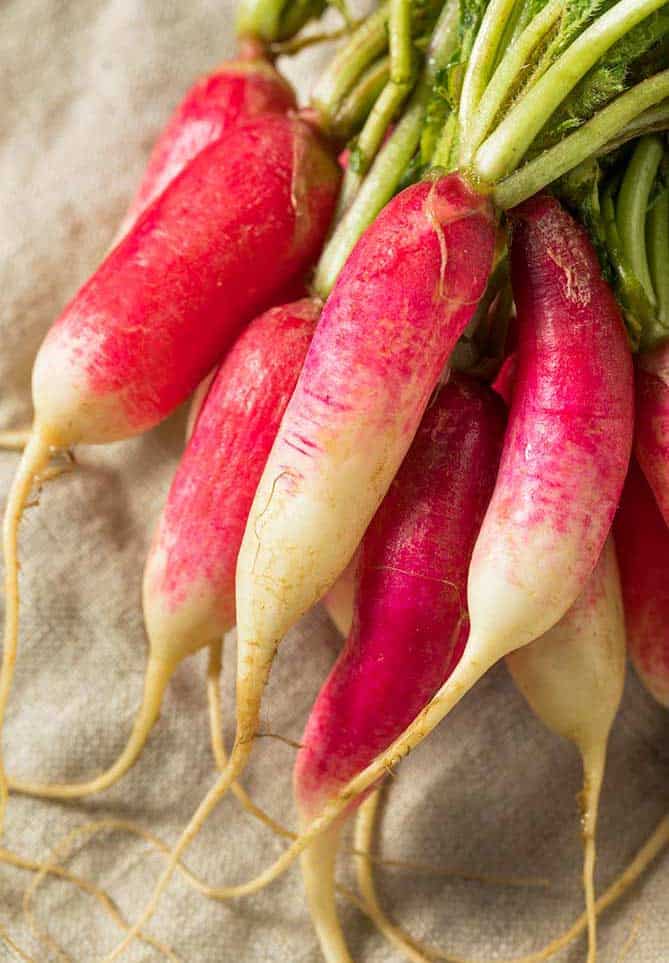
Round Radishes
Round radishes are what pops into most people’s minds when they think of radishes. They come in shades from white to purple, with the most common variety being red. Mixed bunches are marketed as Easter Radishes.
French Breakfast Radishes
French radishes are slightly elongated versions of round radishes. They tend to have a milder flavor than the round versions.
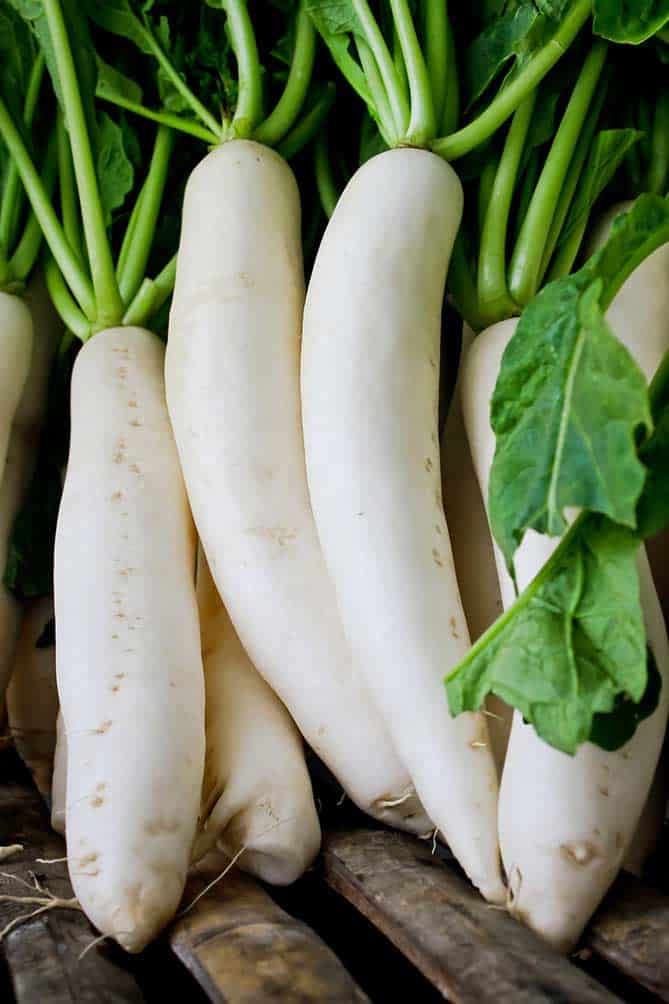
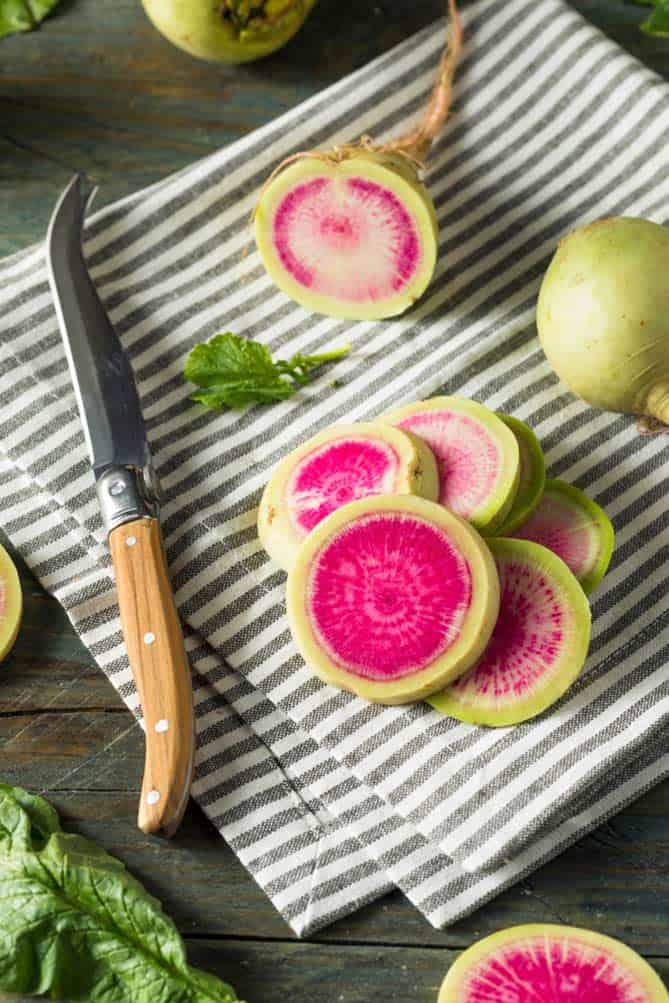
Daikon Radishes (Chinese White Radishes)
Daikon is a mild-flavored winter radish usually characterized by fast-growing leaves and a long, white, root.
When purchasing daikon radish, look for ones no more than 2 inches in diameter. This size tends to have the best flavor along with some wonderful sweetness. Really young daikon – less than 1-inch thick – can be tasteless, and older fat daikon radish can be hot and bitter.
Watermelon Radishes
Watermelon radishes have green skin and a brilliant red-pink interior that is stunningly similar to a watermelon. They are an heirloom variety of daikon radish and originate in China, where they are called shinrimei.
Why does my ferment have a strong odor of rotten eggs?
Sulfur!
Hydrogen sulfide is a flammable, colorless gas with a characteristic odor of rotten eggs. It is commonly known as hydrosulfuric acid, sewer gas, and stink damp. People can smell it at low levels.
—PubChem
Guess what?
Radishes—and cabbage—are especially high in sulfur. Some batches will have a strong odor and many batches very little odor.
I have to thank one of my dear readers for solving this puzzle—and offering a solution.
When sauerkraut is fermenting much of the sulfur converts to hydrogen sulfide which is why the kraut smells a little like dirty diapers when it’s fermenting. The hydrogen sulfide is volatile and blows off as soon as the kraut is exposed to air but, if too much is trapped in the kraut for too long it can convert to compounds called mercaptans which have an unpleasant smell and are not volatile.
What to do about it?
This is what my reader, with a degree in fermentation science, recommends:
If a batch of kraut is particularly stinky during the initial fermentation go ahead and open your jar and mix or stir it to release the hydrogen sulfide gas. Maybe even leave the jar opened for a few hours, stirring it a few more times. Then, push the mixture back down into the jar, put your weight back in, recap the jar, and let your sauerkraut continue to ferment.
But don’t let the chance of these odors stop you from fermenting sulfur-rich foods.
Sulfur is a mineral that is critical to the human body with many health benefits. It is the third most abundant mineral found in our bodies after calcium and phosphorus. So continue to eat—and ferment sulfur-rich foods.
How to Make Fermented Radish and Carrots Slaw
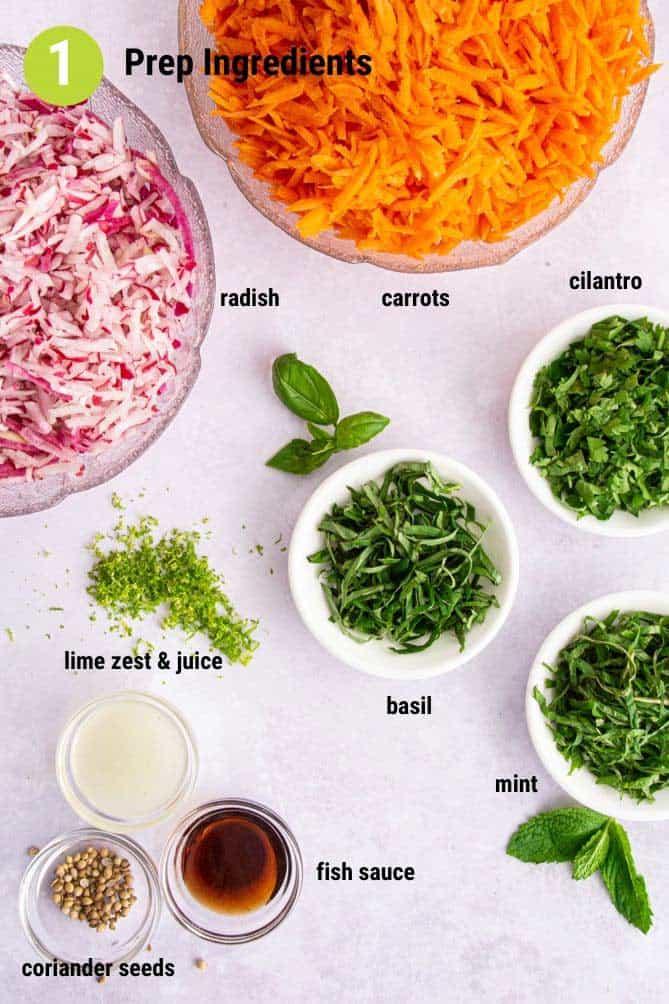
In the picture above are all the ingredients ready to be made into our fermented radish and carrot slaw. I’ll take you through the process step-by-step.
In this recipe, we use a 50-50 combination of prepared radish and carrots and season them with typical Vietnamese herbs and spices: fresh basil, mint, cilantro, and coriander seeds.
To fill a 1-quart (liter) jar you need approximately 800 grams (28 ounces, 1¾ pounds) of ingredients. Your life is so much easier if you weigh your ingredients, using a digital scale, the My Weigh KD-8000 being my favorite.
Set Up Scale
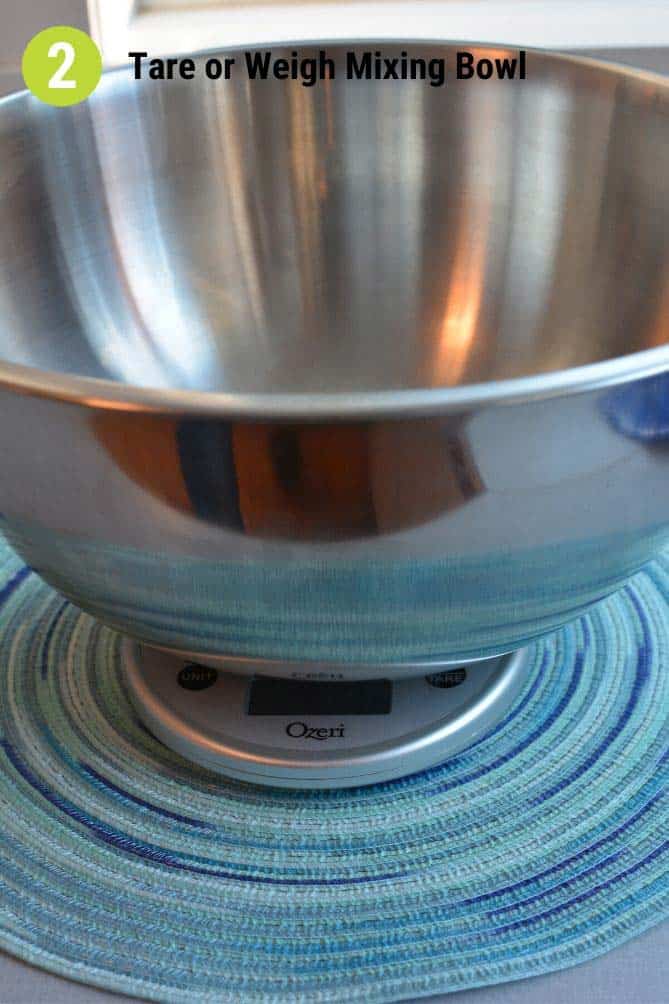
Place your bowl on the scale. Either zero out your scale or write down the tare (weight) of your bowl.
Slice and Chop Herbs and Add to Bowl
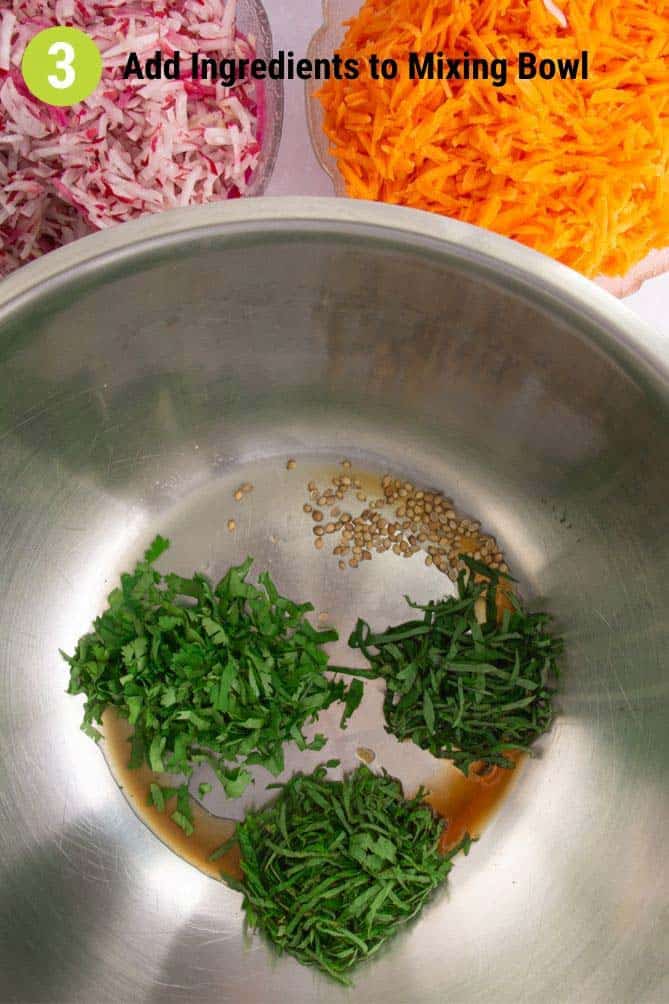
Prep mint, cilantro, basil, and lime (zest and juice) and add to your bowl along with coriander (seeds or powder) and optional fish sauce.
I wanted the fresh herbs in my finished slaw to have a ribbon-like texture so I turned to YouTube to learn how to make fine slices or “chiffonade.” This video by Serious Eats quickly teaches you the steps to chiffonade your mint and basil and chop your cilantro. Some great knife skills to learn.
Grate, or Julienne, Radish and Carrots
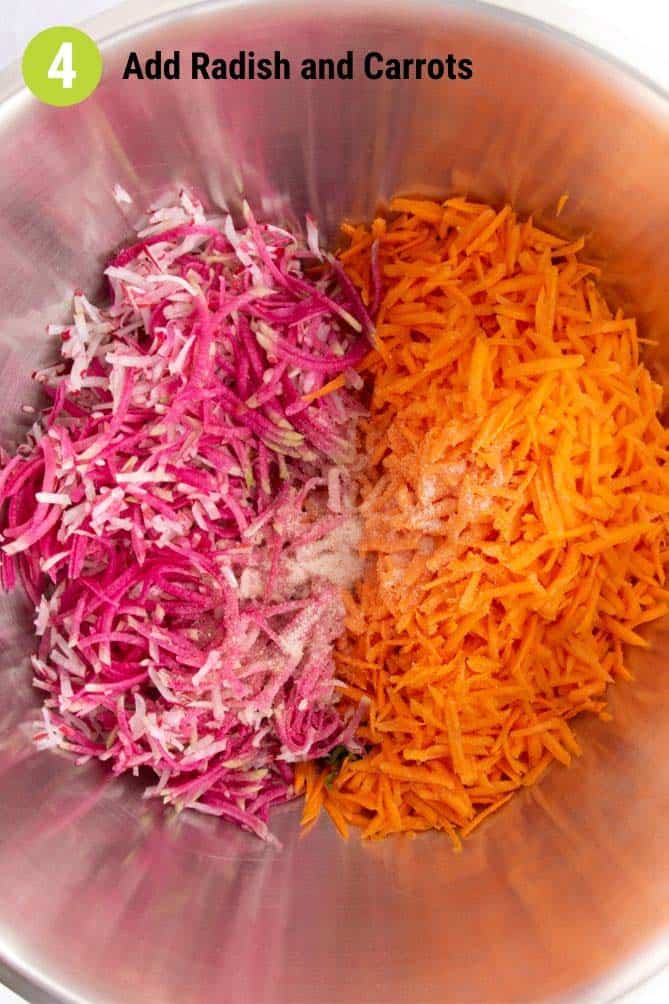
Grate or julienne carrots and add to bowl until the weight of your ingredients is approximately 400 grams (14 oz).
Note: Be sure to take into account the weight of your bowl if you weren’t able to zero out your scale.
For this batch of Fermented Radish and Carrots Slaw, I grated the carrots. You could also julienne the carrots as shown in the How to Cook from Martha video below.
Slice, grate, or julienne the radish(s), depending on the type of radish you’re using. The smaller round radishes work better thinly sliced. Daikon or watermelon radishes work better grated or julienned.
Add prepared radish to the bowl until the weight of your ingredients is approximately 800 grams (1¾ pound or 28 oz).
Note: Be sure to take into account the weight of your bowl if you weren’t able to zero out your scale.
Add Salt and Mix Thoroughly
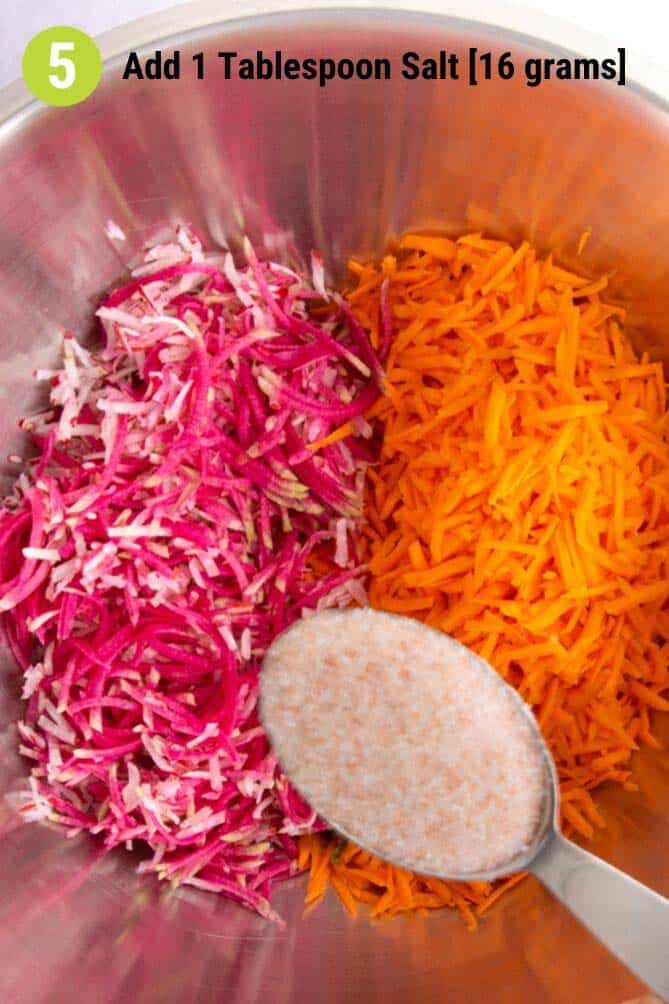
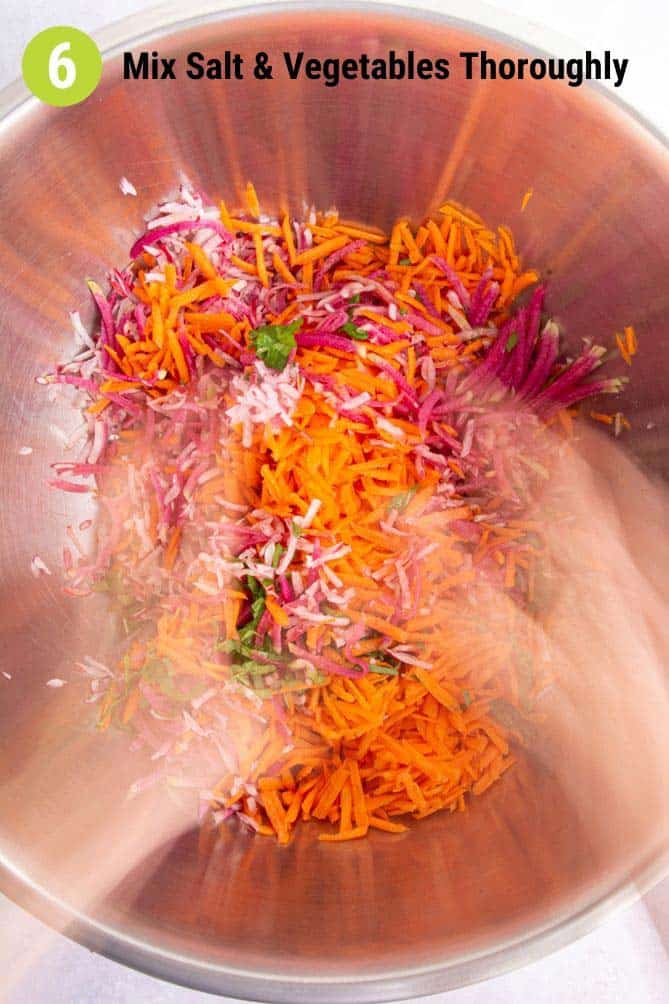
Add 1 tablespoon salt (16 grams) and mix thoroughly until salt is well dispersed. If you are comfortable calculating salt by weight, this recipe uses 2% salt.
Pack Mixture into Jar
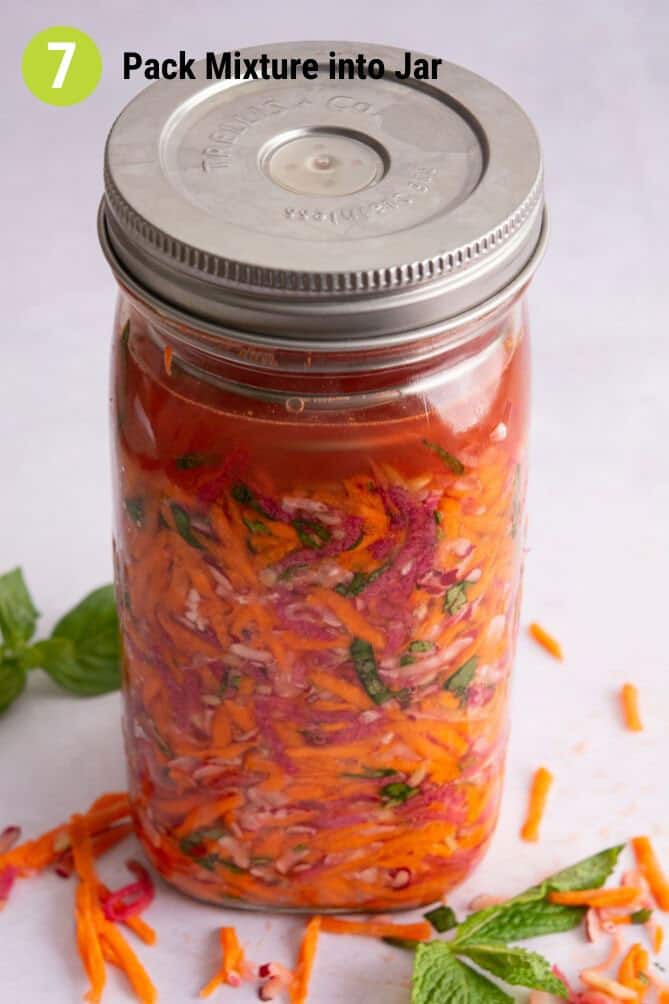
Pack salty mixture into a 1-quart (liter) jar leaving 1-2 inches of headspace. Clean up any loose bits from around the rim and press the mixture down into your jar to remove any air pockets. Seal the jar using a fermentation weight and airlock lid of your choosing.
Ferment
Place your jar in a small bowl to catch any brine that may overflow. Ferment away from direct sunlight for 5-7 days.
How to Know When Your Fermented Radish and Carrots Slaw is Done
During fermentation, bubbles are created that you may see forming on the surface. Colors will fade. You’ll notice it more with the herbs and radish than with the bright carrots.
Wait until Day 5 to taste. It should smell vinegar-like and taste tangy. I find about 7 days to be the sweet spot for fermentation length, which is far less than when making sauerkraut.
If you let it go too long, you may notice a yeasty smell, a tingly sensation on the tongue, and flavors reminiscent of alcohol. It’s still fine to eat, just find a cooler spot and ferment the next batch for a shorter time period.
Ninja Tips for Fermentation Success: Stack the Deck in Your Favor
Keep these three tips in mind to bring your fermentation skills to the next level.
1. Use Fresh Produce
The better your ingredients, the better your finished ferment will be. Traditionally, fermentation was how various cultures preserved the harvest. They only used fresh-picked vegetables and fermented them seasonally. With produce available year-round, we often ferment vegetables that were picked months ago, not ideal for the best results (but a place to start :-).)
The beauty of buying local produce is that it’s been recently picked and should be teeming with the bacteria that will transform the vegetables you used into delicious probiotics. The greater the nutrition in the vegetables you are using, the more food the beneficial bacteria will have to eat, and the better they will work for you. Feed them well.
2. Use a Scale to Weigh your Ingredients and Salt
When putting together a ferment, it’s best to weigh your ingredients to know how much salt to add. A scale will ensure that you:
- Slice the right amount of vegetables to fit in your container.
- Add the correct amount of salt to your ferment to ensure a safe fermentation.
- Don’t waste time and money on vegetables and other ingredients that you had to toss due to the stages of fermentation not properly unfolding.
I recommend a digital scale. Digital scales are more accurate and can easily switch between pounds, ounces, and grams. In addition, a digital scale enables you to measure your salt by weighing it. Since grain sizes vary greatly between salt types and manufacturers, weighing your salt is the most accurate way to add salt to your recipe.
3. Keep the Texture of Prepared Vegetables Similar
A grated radish will ferment much more quickly than a big chunk of carrots. By keeping the size of prepared vegetables about the same, everything will finish fermenting at the same time. You won’t end up with a mushy radish and hard-to-bite carrot.
Gourmet Pairing Tips: 5 Ways to Use that Jar of Fermented Radish and Carrots Slaw Sitting in your Fridge
This Vietnamese-Style Radish Carrots Slaw is easy to throw together and will add freshness and crunch to any meal. Here are some ideas to show you how versatile this ferment is (Don’t forget that you can eat this tangy slaw straight out of the jar.
1. Grilled Chicken Sandwich

Toast a baguette, spread with mayonnaise, add some slices of grilled chicken breast, and top with Vietnamese-Style Fermented Radish and Carrots Slaw.
2. Burger with Sriracha Mayo
Before grilling, season ground meat with dried onion flakes, garlic powder, salt and pepper. Make Sriracha Mayo by stirring 1–2 tablespoons sriracha into ¼ cup of mayonnaise.
Assemble.
Slather your favorite hamburger bun with prepared Sriracha Mayo, add grilled hamburger, and top with a generous portion of Fermented Carrots and Radish Slaw.
3. Taco Topping
Throw together your favorite taco and top with your fermented radish and carrot slaw.
4. Buddha Bowl
Place rice, chopped greens, avocado, and a few fresh veggies, and top with your fermented radish and carrots. Sprinkle on some sesame seeds and drizzle with some tamari sauce and sesame oil.
5. Vietnamese Slaw
Thinly slice and mix together Napa cabbage, sliced shallot(s) or green onions, toasted peanuts, and a pinch of red pepper flakes or my favorite alternative, gochugaru. Toss with a few forkfuls of Vietnamese-Style Fermented Radish and Carrots Slaw, drizzle on some toasted sesame oil, and splash with rice vinegar.
Easy!
Mouthwatering delicious!
Recipe for Vietnamese-Style Fermented Radish and Carrots Slaw
Fermentation Length: 5 to 7 days
Salt Percentage: 2.0% (see Recipe Notes)
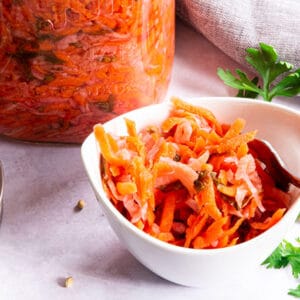
Fermented Radish and Carrots Slaw [Vietnamese Style]
EQUIPMENT
- Kitchen scale, ideally digital
- 1-quart (1 L) wide-mouth canning jar or similar sized jar
- 4-ounce (125 ml) canning jar (jelly jar) or other fermentation weight
- Wide-mouth plastic storage cap, canning jar rim, and lid, or airlock lid of your choosing
- Cutting board and chef’s knife
- Large mixing bowl
- Vegetable peeler and measuring spoons
INGREDIENTS
- ¼ cup (60 ml) fresh mint, thinly sliced
- ¼ cup (60 ml) fresh cilantro, thinly sliced
- ¼ cup (60 ml) fresh basil, thinly sliced
- 1 teaspoon (5 ml) coriander seeds, gently crushed (see Recipe Notes) or, , ½ teaspoon (2 ml) coriander powder
- 1 lime, zest and juice of
- 1 tablespoon (15 ml) fish sauce , (optional)
- 1 pound (450 g) approx. radish, grated or sliced (see Recipe Notes)
- 1 pound (450 g) approx. carrots, peeled and grated
- 1 tablespoon (15 ml) fine-grain iodine-free salt
INSTRUCTIONS
- Place your bowl on the scale. Either zero out your scale or write down the tare (weight) of your bowl.
- Prep your mint, cilantro, basil, and lime (zest and juice) and add to your bowl along with coriander (seeds or powder) and optional fish sauce. See embedded video above to learn how to cut the herbs using the chiffonade technique. It's fun and the results are worth it. 🙂
- Grate the carrots. Slice or grate the radish, depending on the type of radish you’re using. A nice touch is to julienne or spiralizer the carrots (and daikon, is using). See embedded video above to learn how to julienne. Just be sure not to end up with too fine a cut. You need just under a pound (400 grams) of each. The smaller radishes could also be thinly sliced.
- Add radish and carrots to your bowl until the weight of all your ingredients is 1 ¾ pound (28 oz or 800 g).
- Sprinkle with 1 tablespoon (15 ml) of salt. Mix thoroughly until salt is well dispersed.
- Pack into a 1-quart (liter) jar leaving 1-2 inches of headspace. Clean up any loose bits from around the rim and press the mixture down into your jar to remove any air pockets.
- Seal the jar using a fermentation weight and airlock lid of your choosing. If you don’t have a specialty weight, find a slightly smaller jar that will fit inside the neck of the jar you packed your ferment into. Fill it with water, cap it, and place it inside the jar. It will keep your ferment below the brine and safe from airborne molds and yeasts.
- Label your jar with the recipe name and the day you started fermenting. Place your jar in a small bowl to catch any brine that may overflow. Ferment away from direct sunlight for 5-7 days.
- Start tasting on day 5, stopping fermentation when the desired flavor and acidity is achieved. I keep the fermentation length short for this ferment because I find with sweet carrots, it’s easy for this ferment to switch to an alcohol ferment with notes of yeast. Not what we want.
- When fermented to your liking, clean up the jar, removing the fermentation weight and airlock lid. Add how long you fermented your Fermented Radish and Carrots Slaw to your label. Seal your jar with a regular lid and transfer to the fridge where your ferment will keep for 6-12 months.
Notes and Tips
- Toss, or cut out, any woody or brown bits you may find in your radishes.
- If using watermelon or daikon radishes, first peel them. Due to their size, you might want to grate them. You do not need to peel the small, spring radishes. Since they are so small, it works better to thinly slice them.
- To release the flavor of the coriander seeds, first gently crush them with the back of a spoon.
- Fish sauce is rich in flavor-enhancing compounds that add complex notes to any dish. If the smell turns you off, hold your nose while pouring. The fishy odor is greatly diminished during the fermentation process leaving behind remarkable flavors.
- Red Boat is my preferred brand of fish sauce. When shopping for fish sauce, carefully read the label. The best quality of fish sauce will be made with just anchovies and salt.
- If you are comfortable with weighing your ingredients and calculating salt by weight, this recipe uses 2% salt. To determine how many grams of salt to add, multiply the weight of your ingredients by 0.02 and add that many grams of salt. For example, an 800 gram batch of ingredients would call for 16 grams of salt. (800 x 0.02 = 16)
- Himalayan pink salt or Redmond Real Salt© are my favorite salts to use for fermentation.
A Jar of 7 Fermented Vegetables Ready to Add to Any Meal
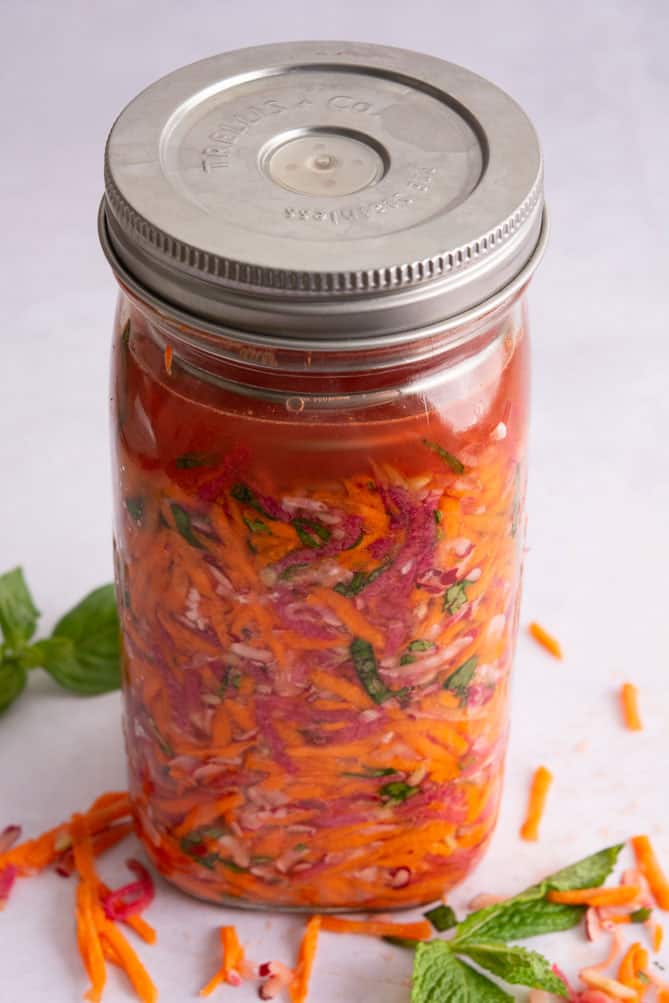
Once you have a jar of Vietnamese-Style Fermented Radish and Carrots Slaw at the ready in your fridge, throwing together a flavorful, healthy meal is so much easier. It’s now pay-off time for the work you—and the bodacious bacteria—did weeks ago. The ultimate fast food
Other Flavorful Ways to Make Meals Easy
Both my Fermented Fennel Celery Salad Topper and Pickle Relish Kimchi—found on MyFermentation—are great for adding to any dish or meal.
I use my stash of fermented garlic paste to flavor sauteed greens, pasta dishes, and soups, and stews.
And, I keep a grated batch of fermented beets for adding to salads. High in minerals and great for your liver.
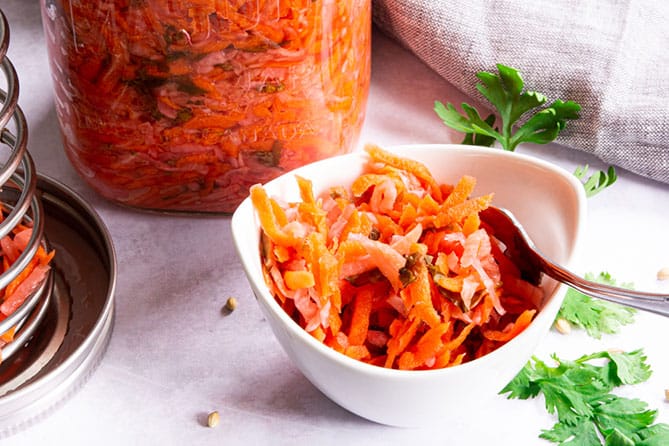


 This post may contain affiliate links which won’t change your price but will share some commission.
This post may contain affiliate links which won’t change your price but will share some commission.